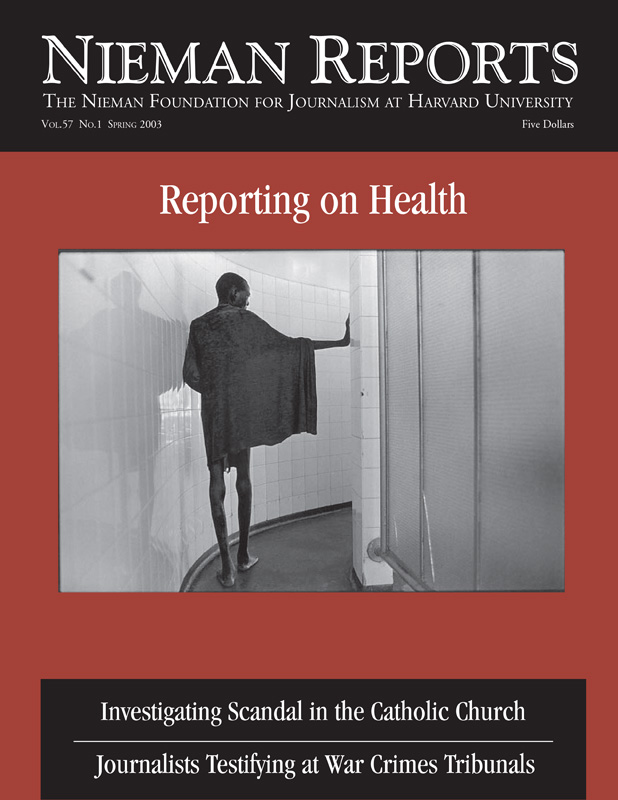The September 11th attacks dramatically changed and constrained the way journalists— especially public health reporters—are able to do their jobs. I submitted the manuscript of my book, “Secret Agents: The Menace of Emerging Infections,” exactly three weeks before September 11th. Since then I’ve observed and dealt with disturbing new restrictions. For the two-and-a-half years I was researching my book, I felt I had full access to public health experts at all levels of government and academia. But the gates have closed. Now a journalist must negotiate an obstacle course of silence and spin, bland obfuscations and tightly controlled facts. Simply put, in this new climate I could never have written my book.
Although I didn’t realize it at the time, when I began my research in early 1999, a window had briefly opened for medical reporters. The U.S. government had started to acknowledge the wretched condition of public health in this country. The full spectrum of neglect was glaring: obsolete labs, archaic data collection systems, rigid organizational fiefdoms, and demoralized workers. That autumn, the startling arrival of the West Nile virus exposed the system’s gaps and flaws.
Insiders were willing to talk about this deteriorating state of affairs. In an atmosphere of heightened awareness, unfettered by any explicit emergency— and free of a White House that micromanages the pronouncements of government employees—I was able to travel and conduct hundreds of interviews. Even at the time, I reveled in a sense of journalistic spaciousness.
Access to Sources
RELATED ARTICLE
“The Anthrax Attacks”
– Patricia ThomasIn New York City, I spent a day with a tough-talking veterinary technician, driving to the secretly sited “sentinel chickens” whose antibodies warned of the West Nile virus. Such a leisurely lark under government auspices would surely be banned today. In Baltimore, I strolled along the harbor with D.A. Henderson, the crusty public health icon who had directed the World Health Organization’s smallpox eradication campaign in the 1960’s and ’70’s; nine months later, he was bunkered and virtually unreachable back in Washington, enlisted to help brace the nation for a possible return of the scourge he had extinguished. In Atlanta, I spent a week hanging out with scientists in the Centers for Disease Control and Prevention’s (CDC) foodborne infections branch, as endless reports of salmonella and listeria and E. coli swept through the warren of basement offices; today, the CDC has become a frontline command post for the war on terrorism, one that strangers with steno pads cannot breach.
Above all, I enjoyed long and repeated interviews with federal, state and local public health officials. I could call up a source at the CDC, or anywhere else, and ask a question—and get an answer. Public health was not a state secret: It was public.
No more. In order to converse with anyone at the CDC, a reporter must now make a formal request, which can take weeks to be processed through a complex public affairs filtration system that reaches all the way to the Washington, D.C. headquarters of the U.S. Department of Health and Human Services. If the interview actually takes place—little guarantee, there—it will be monitored by a public affairs minder ostensibly on the call to offer relevant “resources,” but in fact there to corral the discussion and closely watch the clock. Talk about the corporate model of government: A reporter would have more latitude grilling the CEO’s of Merrill Lynch or ExxonMobil.
Don’t get me wrong. In recent months, I have been able to interview the CDC director, state and local health officials, emergency room physicians, public safety managers, and others, trying to make sense of this new national puzzle. But there’s an unmistakable chill in the air.
Admittedly, health workers at all levels are toiling triple-overtime these days, girding their departments for terrorism and carrying out the White House smallpox vaccination plan, all while trying to hold back the daily, unpublicized tide of disease. They have precious little time to talk to their spouses and children, let alone to journalists. But reporters—and readers— desperately need access to the facts, now more than ever. What evidence is there for an imminent smallpox virus release? How exactly did the White House settle on its controversial vaccination plan? What will happen if, in an emergency, public health is subsumed under public safety? Will the Department of Homeland Security forever change the face of the CDC?
The Stories That Get Missed
Perhaps most important, in this era of all-smallpox-all-the-time, is how are we faring against other health threats right on our doorstep? If, on September 10, 2001, a public health reporter had asked CDC leaders what peril most preoccupied them, most would have said antibiotic- resistant bacteria, which have fueled an inexorable rise in deaths and illness in both hospitals and our communities. Ask these officials the same question today, off the record, and they might well answer the same way. In the past year, every dreaded prediction about drug-resistant staph and other organisms has come to pass, but these alarming developments have been overshadowed by more speculative—if more dramatic—headlines.
Likewise, pandemic flu remains poised to leap out of Asia. Meat recalls of record proportions are quietly announced in dry bureaucratic prose. West Nile virus has surged across the entire Western Hemisphere. AIDS is spreading its devastation from Africa to India and Asia. Now, as throughout all of history, the most talented bioterrorist remains nature itself. Yet, in the fog of war preparations, we have lost sight of the bigger picture.
Three weeks after I submitted the manuscript of “Secret Agents,” the unimaginable happened. Three weeks later, anthrax broke out. As galleys and page proofs and final edits piled up on my desk, I furiously reworked my long chapter on bioterrorism, trying to chase a moving target. With hourly news dispatches jerking me this way and that, composing a “first draft of history” left me with a distinctly sick feeling. The day before Christmas 2001, I gritted my teeth and sent off the pages to my publisher. Fortunately for the hardcover edition of my book, but unhappily for the rest of the country, the anthrax story hasn’t appreciably advanced since then. Why not? That’s another unanswered question.
Public health only gets support when it’s politically strategic. During the past year, billions of dollars have been poured into health departments at all levels of government—but it’s not necessarily being spent in the most effective ways. In the name of preparedness, weary officials are trying to solve the same problems across the country, inevitably duplicating efforts. The endemic problems in America’s public health system—short staffing, spotty training, heavy bureaucracy—endure.
And that might be the biggest untold story in public health today: How is the vast, unsung network of people and labs and communications that protects all of us from disease being transformed by the recent emergency infusion of cash and attention? Is it a cosmetic fix or a long-term cure? Five years from now, will we be better defended not only against terrorist-sown diseases, but also against contaminated poultry or childhood whooping cough? Will more elderly citizens be immunized against flu and pneumonia? Will hospital infection rates have dropped? And, if journalists are still struggling just to talk with authorities in the know, how will the public ever find out?
Madeline Drexler is a Boston-based journalist. The paperback edition of “Secret Agents: The Menace of Emerging Infections,” is due to be published by Penguin in March. A former medical columnist for The Boston Globe Magazine, she was a Knight Science Journalism Fellow at the Massachusetts Institute of Technology.




